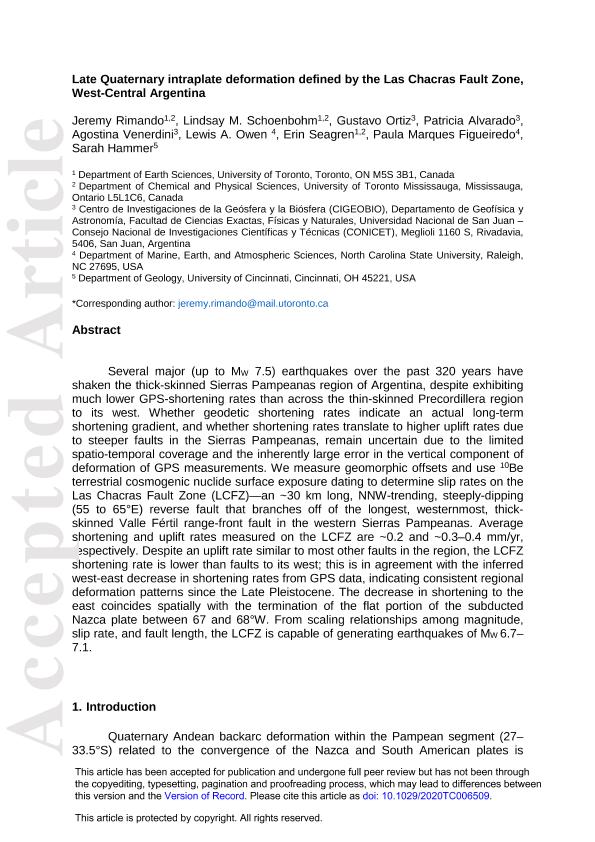Mostrar el registro sencillo del ítem
dc.contributor.author
Rimando, Jeremy

dc.contributor.author
Schoenbohm, Lindsay

dc.contributor.author
Ortiz, Gustavo Federico

dc.contributor.author
Alvarado, Patricia Monica

dc.contributor.author
Venerdini, Agostina Lia

dc.contributor.author
Owen, Lewis

dc.contributor.author
Seagren, Erin
dc.contributor.author
Marques Figueiredo, Paula
dc.contributor.author
Hammer, Sarah
dc.date.available
2023-01-05T12:08:02Z
dc.date.issued
2021-04
dc.identifier.citation
Rimando, Jeremy; Schoenbohm, Lindsay; Ortiz, Gustavo Federico; Alvarado, Patricia Monica; Venerdini, Agostina Lia; et al.; Late Quaternary intraplate deformation defined by the Las Chacras Fault Zone, West‐Central Argentina; Wiley Blackwell Publishing, Inc; Tectonics; 40; 4; 4-2021; 1-48
dc.identifier.issn
0278-7407
dc.identifier.uri
http://hdl.handle.net/11336/183466
dc.description.abstract
Several major (up to MW 7.5) earthquakes over the past 320 years have shaken the thick-skinned Sierras Pampeanas region of Argentina, despite exhibiting much lower GPS-shortening rates than across the thin-skinned Precordillera region to its west. Whether geodetic shortening rates indicate an actual long-term shortening gradient, and whether shortening rates translate to higher uplift rates due to steeper faults in the Sierras Pampeanas, remain uncertain due to the limited spatio-temporal coverage and the inherently large error in the vertical component of deformation of GPS measurements. We measure geomorphic offsets and use 10Be terrestrial cosmogenic nuclide surface exposure dating to determine slip rates on the Las Chacras Fault Zone (LCFZ)—an ∼30 km long, NNW-trending, steeply dipping (55–65°E) reverse fault that branches off of the longest, westernmost, thick-skinned Valle Fértil range-front fault in the western Sierras Pampeanas. Average shortening and uplift rates measured on the LCFZ are ∼0.2 and ∼0.3–0.4 mm/yr, respectively. Despite an uplift rate similar to most other faults in the region, the LCFZ shortening rate is lower than faults to its west; this is in agreement with the inferred west-east decrease in shortening rates from GPS data, indicating consistent regional deformation patterns since the Late Pleistocene. The decrease in shortening to the east coincides spatially with the termination of the flat portion of the subducted Nazca plate between 67 and 68°W. From scaling relationships among magnitude, slip rate, and fault length, the LCFZ is capable of generating earthquakes of MW 6.7–7.1.
dc.format
application/pdf
dc.language.iso
eng
dc.publisher
Wiley Blackwell Publishing, Inc

dc.rights
info:eu-repo/semantics/openAccess
dc.rights.uri
https://creativecommons.org/licenses/by-nc-sa/2.5/ar/
dc.subject
ACTIVE FAULTS
dc.subject
COSMOGENIC DATING
dc.subject
INTRAPLATE FAULTS
dc.subject
NEOTECTONICS
dc.subject
SEISMIC HAZARDS
dc.subject
THICK-SKINNED DEFORMATION
dc.subject.classification
Geociencias multidisciplinaria

dc.subject.classification
Ciencias de la Tierra y relacionadas con el Medio Ambiente

dc.subject.classification
CIENCIAS NATURALES Y EXACTAS

dc.title
Late Quaternary intraplate deformation defined by the Las Chacras Fault Zone, West‐Central Argentina
dc.type
info:eu-repo/semantics/article
dc.type
info:ar-repo/semantics/artículo
dc.type
info:eu-repo/semantics/publishedVersion
dc.date.updated
2022-09-20T19:21:34Z
dc.identifier.eissn
1944-9194
dc.journal.volume
40
dc.journal.number
4
dc.journal.pagination
1-48
dc.journal.pais
Estados Unidos

dc.journal.ciudad
Nueva York
dc.description.fil
Fil: Rimando, Jeremy. University of Toronto; Canadá
dc.description.fil
Fil: Schoenbohm, Lindsay. University of Toronto; Canadá
dc.description.fil
Fil: Ortiz, Gustavo Federico. Consejo Nacional de Investigaciones Científicas y Técnicas. Centro Científico Tecnológico Conicet - San Juan. Centro de Investigaciones de la Geosfera y Biosfera. Universidad Nacional de San Juan. Facultad de Ciencias Exactas Físicas y Naturales. Centro de Investigaciones de la Geosfera y Biosfera; Argentina. Universidad Nacional de San Juan. Facultad de Ciencias Exactas, Físicas y Naturales. Departamento de Geofísica y Astronomía; Argentina
dc.description.fil
Fil: Alvarado, Patricia Monica. Consejo Nacional de Investigaciones Científicas y Técnicas. Centro Científico Tecnológico Conicet - San Juan. Centro de Investigaciones de la Geosfera y Biosfera. Universidad Nacional de San Juan. Facultad de Ciencias Exactas Físicas y Naturales. Centro de Investigaciones de la Geosfera y Biosfera; Argentina. Universidad Nacional de San Juan. Facultad de Ciencias Exactas, Físicas y Naturales. Departamento de Geofísica y Astronomía; Argentina
dc.description.fil
Fil: Venerdini, Agostina Lia. Consejo Nacional de Investigaciones Científicas y Técnicas. Centro Científico Tecnológico Conicet - San Juan. Centro de Investigaciones de la Geosfera y Biosfera. Universidad Nacional de San Juan. Facultad de Ciencias Exactas Físicas y Naturales. Centro de Investigaciones de la Geosfera y Biosfera; Argentina. Universidad Nacional de San Juan. Facultad de Ciencias Exactas, Físicas y Naturales. Departamento de Geofísica y Astronomía; Argentina
dc.description.fil
Fil: Owen, Lewis. North Carolina State University; Estados Unidos
dc.description.fil
Fil: Seagren, Erin. University of Toronto; Canadá
dc.description.fil
Fil: Marques Figueiredo, Paula. North Carolina State University; Estados Unidos
dc.description.fil
Fil: Hammer, Sarah. University of Cincinnati; Estados Unidos
dc.journal.title
Tectonics

dc.relation.alternativeid
info:eu-repo/semantics/altIdentifier/url/https://onlinelibrary.wiley.com/doi/10.1029/2020TC006509
dc.relation.alternativeid
info:eu-repo/semantics/altIdentifier/doi/https://doi.org/10.1029/2020TC006509
Archivos asociados
